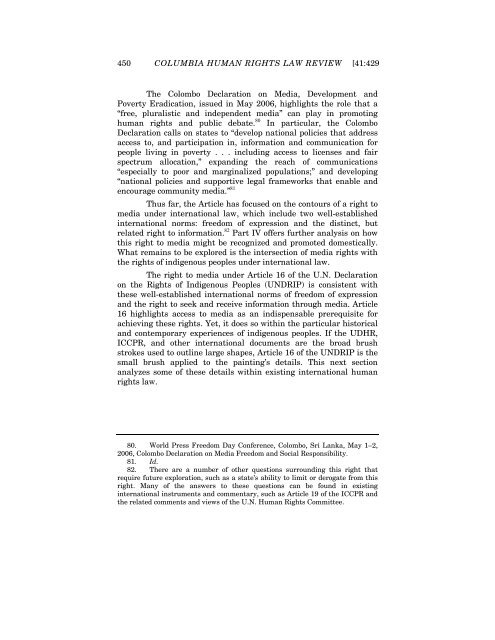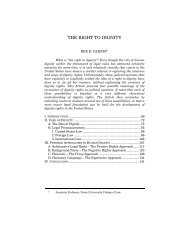A Right to Media? Lorie M. Graham - Columbia Law School
A Right to Media? Lorie M. Graham - Columbia Law School
A Right to Media? Lorie M. Graham - Columbia Law School
Create successful ePaper yourself
Turn your PDF publications into a flip-book with our unique Google optimized e-Paper software.
450 COLUMBIA HUMAN RIGHTS LAW REVIEW [41:429<br />
The Colombo Declaration on <strong>Media</strong>, Development and<br />
Poverty Eradication, issued in May 2006, highlights the role that a<br />
“free, pluralistic and independent media” can play in promoting<br />
human rights and public debate. 80 In particular, the Colombo<br />
Declaration calls on states <strong>to</strong> “develop national policies that address<br />
access <strong>to</strong>, and participation in, information and communication for<br />
people living in poverty . . . including access <strong>to</strong> licenses and fair<br />
spectrum allocation,” expanding the reach of communications<br />
“especially <strong>to</strong> poor and marginalized populations;” and developing<br />
“national policies and supportive legal frameworks that enable and<br />
encourage community media.” 81<br />
Thus far, the Article has focused on the con<strong>to</strong>urs of a right <strong>to</strong><br />
media under international law, which include two well-established<br />
international norms: freedom of expression and the distinct, but<br />
related right <strong>to</strong> information. 82 Part IV offers further analysis on how<br />
this right <strong>to</strong> media might be recognized and promoted domestically.<br />
What remains <strong>to</strong> be explored is the intersection of media rights with<br />
the rights of indigenous peoples under international law.<br />
The right <strong>to</strong> media under Article 16 of the U.N. Declaration<br />
on the <strong>Right</strong>s of Indigenous Peoples (UNDRIP) is consistent with<br />
these well-established international norms of freedom of expression<br />
and the right <strong>to</strong> seek and receive information through media. Article<br />
16 highlights access <strong>to</strong> media as an indispensable prerequisite for<br />
achieving these rights. Yet, it does so within the particular his<strong>to</strong>rical<br />
and contemporary experiences of indigenous peoples. If the UDHR,<br />
ICCPR, and other international documents are the broad brush<br />
strokes used <strong>to</strong> outline large shapes, Article 16 of the UNDRIP is the<br />
small brush applied <strong>to</strong> the painting’s details. This next section<br />
analyzes some of these details within existing international human<br />
rights law.<br />
80. World Press Freedom Day Conference, Colombo, Sri Lanka, May 1–2,<br />
2006, Colombo Declaration on <strong>Media</strong> Freedom and Social Responsibility.<br />
81. Id.<br />
82. There are a number of other questions surrounding this right that<br />
require future exploration, such as a state’s ability <strong>to</strong> limit or derogate from this<br />
right. Many of the answers <strong>to</strong> these questions can be found in existing<br />
international instruments and commentary, such as Article 19 of the ICCPR and<br />
the related comments and views of the U.N. Human <strong>Right</strong>s Committee.















